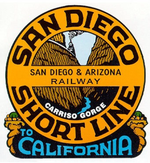San Diego and Arizona Railway
 |
|
| Reporting mark | SDA |
|---|---|
| Locale |
California Mexico |
| Dates of operation | 1919–1984 |
| Successor | Southern Pacific |
| Track gauge | 4 ft 8 1⁄2 in (1,435 mm) standard gauge |
| Length | 129 miles (208 kilometres) |
| Headquarters | San Diego, California |
The San Diego and Arizona Railway (reporting mark SDA) was a short line U.S. railroad founded by entrepreneur John D. Spreckels, and dubbed "The Impossible Railroad" by engineers of its day due to the immense logistical challenges involved. Established in part to provide San Diego with a direct transcontinental rail link to the east by connecting with the Southern Pacific Railroad (which secretly provided the funding for the endeavor) lines in El Centro, California, the 148-mile (238 km) route of the SD&A originated in San Diego, California and terminated in El Centro, California.
The company charter was executed on December 14, 1906, and the groundbreaking ceremony was held the following September. Numerous delays (including government intervention during World War I) delayed the completion of the line to November 15, 1919. Damage to the lines from both natural disasters and sabotage exerted great financial pressure on the company, and in 1932 Spreckels' heirs sold their interests in the railroad to the Southern Pacific, which was named the San Diego & Arizona Eastern Railway (SD&AE).
The company was chartered on December 14, 1906, and groundbreaking ceremonies held at the intersection of San Diego's Main and 26th Streets on September 7, 1907. Construction delays, attacks by Mexican revolutionaries, and government intervention during World War I all served to push the construction completion to November 15, 1919 when the "golden spike" was finally driven by none other than John Spreckels himself.
The first through SD&A passenger train left Campo on the morning of November 30, and made the full run from El Centro to San Diego's downtown Union Station for the official opening of the line on December 1, 1919. The total construction cost of the 146.4 miles (235.6 km) of track laid was approximately $18 million, or some $123,000 per mile; the original estimate was $6 million. The 11-mile (18 km) long segment through Carrizo Gorge (which included 13,385 feet (4,080 m) of tunnels, 17 in all) alone cost over $4 million to construct; the three miles (5 km) of tunnels (21 total) along the entire line ran another $1.8 million. Almost 2.5 miles (4.0 km) of bridges and trestles were built as well.
...
Wikipedia
